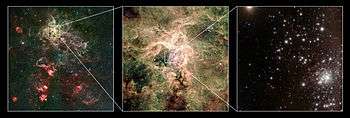Melnick 34
 Photograph of Melnick 34 taken by the Wide Field and Planetary Camera of the Hubble Space Telescope. | |
| Observation data Epoch J2000.0 Equinox J2000.0 | |
|---|---|
| Constellation | Dorado |
| Right ascension | 5h 38m 44.26s[1] |
| Declination | −69° 06′ 05.88″[1] |
| Apparent magnitude (V) | 13.09[1] |
| Characteristics | |
| Evolutionary stage | Wolf–Rayet star |
| Spectral type | WN5h:a[2] |
| B−V color index | +0.25[1] |
| Astrometry | |
| Distance | 163,000 ly (49,970[3] pc) |
| Absolute magnitude (MV) | -7.9[1] |
| Details | |
| Mass | 179[4] M☉ |
| Radius | 20[2] R☉ |
| Luminosity | 7,079,000[5] L☉ |
| Temperature | 53,000[1] K |
| Age | ~1.7[6] Myr |
| Other designations | |
| Database references | |
| SIMBAD | data |
BAT99-116 (commonly called Melnick 34 or Mk34) is a massive luminous Wolf–Rayet star near R136 in the 30 Doradus complex (also known as the Tarantula Nebula) in the Large Magellanic Cloud.
Physical characteristics
Mk34 is a Wolf–Rayet star with surface temperature over 50,000 K .[2][1] It is estimated that at its birth the star was around 275 M☉.[5] It has a powerful stellar wind and despite its young age it has already shed a large fraction of its initial mass.[4] However, due to high x-ray luminosity and some radial velocity variations, it is expected that Mk34 has a hot luminous companion, so estimates of its temperature, luminosity, and mass are highly uncertain.[2]
Evolution
Mk34 is currently burning hydrogen in its core, although it shows strong helium and nitrogen emission due to convection of fusion products from the core to the surface. It is expected that it will evolve quickly to a hydrogen-free Wolf-Rayet star, possibly with a short time as a blue hypergiant and luminous blue variable. It will then shed more and more of its outer layers, ultimately becoming a WO star close to 200,000 K before collapsing, producing a type Ic supernova and leaving behind a black hole.[7]
References
- 1 2 3 4 5 6 7 Doran, E. I.; Crowther, P. A.; de Koter, A.; Evans, C. J.; McEvoy, C.; Walborn, N. R.; Bastian, N.; Bestenlehner, J. M.; Grafener, G.; Herrero, A.; Kohler, K.; Maiz Apellaniz, J.; Najarro, F.; Puls, J.; Sana, H.; Schneider, F. R. N.; Taylor, W. D.; van Loon, J. Th.; Vink, J. S. (2013). "The VLT-FLAMES Tarantula Survey - XI. A census of the hot luminous stars and their feedback in 30 Doradus". Astronomy & Astrophysics. 558: 134. arXiv:1308.3412
 . Bibcode:2013A&A...558A.134D. doi:10.1051/0004-6361/201321824.
. Bibcode:2013A&A...558A.134D. doi:10.1051/0004-6361/201321824. - 1 2 3 4 Hainich, R.; Rühling, U.; Todt, H.; Oskinova, L. M.; Liermann, A.; Gräfener, G.; Foellmi, C.; Schnurr, O.; Hamann, W. -R. (2014). "The Wolf-Rayet stars in the Large Magellanic Cloud". Astronomy & Astrophysics. 565: A27. arXiv:1401.5474
 . Bibcode:2014A&A...565A..27H. doi:10.1051/0004-6361/201322696.
. Bibcode:2014A&A...565A..27H. doi:10.1051/0004-6361/201322696. - ↑ Pietrzyński, G; D. Graczyk; W. Gieren; I. B. Thompson; B. Pilecki; A. Udalski; I. Soszyński; et al. (7 March 2013). "An eclipsing-binary distance to the Large Magellanic Cloud accurate to two per cent". Nature. 495 (7439): 76–79. arXiv:1303.2063
 . Bibcode:2013Natur.495...76P. doi:10.1038/nature11878. PMID 23467166.
. Bibcode:2013Natur.495...76P. doi:10.1038/nature11878. PMID 23467166. - 1 2 Portegies Zwart, Simon F.; Pooley, David; Lewin, Walter H. G. (2002). "A Dozen Colliding-Wind X-Ray Binaries in the Star Cluster R136 in the 30 Doradus Region". The Astrophysical Journal. 574 (2): 762. arXiv:astro-ph/0106109
 . Bibcode:2002ApJ...574..762P. doi:10.1086/340996.
. Bibcode:2002ApJ...574..762P. doi:10.1086/340996. - 1 2 Crowther, Paul A.; Caballero-Nieves, S. M.; Bostroem, K. A.; Maíz Apellániz, J.; Schneider, F. R. N.; Walborn, N. R.; Angus, C. R.; Brott, I.; Bonanos, A.; De Koter, A.; De Mink, S. E.; Evans, C. J.; Gräfener, G.; Herrero, A.; Howarth, I. D.; Langer, N.; Lennon, D. J.; Puls, J.; Sana, H.; Vink, J. S. (2016). "The R136 star cluster dissected with Hubble Space Telescope/STIS. I. Far-ultraviolet spectroscopic census and the origin of He II λ1640 in young star clusters". Monthly Notices of the Royal Astronomical Society. 458: 624. arXiv:1603.04994
 . Bibcode:2016MNRAS.458..624C. doi:10.1093/mnras/stw273.
. Bibcode:2016MNRAS.458..624C. doi:10.1093/mnras/stw273. - ↑ Crowther, P. A.; Schnurr, O.; Hirschi, R.; Yusof, N.; Parker, R. J.; Goodwin, S. P.; Kassim, H. A. (2010). "The R136 star cluster hosts several stars whose individual masses greatly exceed the accepted 150 M⊙ stellar mass limit". Monthly Notices of the Royal Astronomical Society. 408 (2): 731. arXiv:1007.3284
 . Bibcode:2010MNRAS.408..731C. doi:10.1111/j.1365-2966.2010.17167.x.
. Bibcode:2010MNRAS.408..731C. doi:10.1111/j.1365-2966.2010.17167.x. - ↑ Groh, J. H.; Meynet, G.; Georgy, C.; Ekström, S. (2013). "Fundamental properties of core-collapse supernova and GRB progenitors: Predicting the look of massive stars before death". Astronomy & Astrophysics. 558: A131. arXiv:1308.4681
 . Bibcode:2013A&A...558A.131G. doi:10.1051/0004-6361/201321906.
. Bibcode:2013A&A...558A.131G. doi:10.1051/0004-6361/201321906.
External links
Coordinates: ![]() 05h 38m 44.25s, −69° 06′ 05.8″
05h 38m 44.25s, −69° 06′ 05.8″
